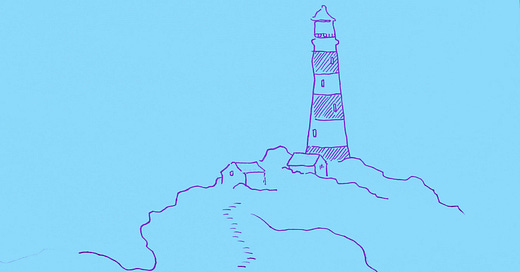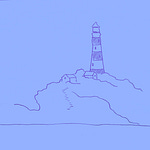Hello friends!
Today, if you are reading with us, we’re finishing up ‘Time Passes’ (the second of the three parts that make up Virginia Woolf’s novel, To the Lighthouse) and preparing to start the final leg of the book – ‘The Lighthouse.’
Our reading schedule is here if you need it, and all the To the Lighthouse posts are here.
In this post, I’m sharing a new conversation with the wonderful
about ‘Time Passes.’ (Thank you so much, Nancy!) In addition, in this post:A short SUMMARY of ‘Time Passes’
A few brief THOUGHTS and OBSERVATIONS
Information about WHAT’S NEXT
1. A short summary of ‘Time Passes’
The ‘Time Passes’ section of the novel starts where ‘The Window’ finishes. After the dinner party, a group of people have gone down to the beach to watch the waves. They now return to the house and turn off the last lights. Darkness begins to blot out the world.
The family now disappear from the house and it stands empty for many years. Seasons come and go. Sounds now and then intrude from the outside world but the house is otherwise silent. Soon, things begin to break down and decay. Though the focus is on the world of the empty house, we hear fragmentary details about the Ramsay family. Mrs Ramsay has died suddenly at some point. Prue Ramsay marries but soon dies in childbirth. Andrew Ramsay, fighting in France, is killed in action. Mr Carmichael publishes a book of poetry.
The house further degrades under the effect of weather, time, and a lack of maintenance, until finally Mrs McNab and Mrs Bast come to bring the house back from the brink of total decay. They clean up as best they can in preparation for the return of some members of the Ramsay family (many years after the previous visit), along with a few of their guests – Lily Briscoe, Mr Carmichael, Mrs Beckwith. People arrive in the evening and, weary from their journey, go to bed. ‘Time Passes’ ends with Lily Briscoe waking up the next morning; a new day dawns.
2. A few brief thoughts and observations
Different registers of time overlaid
It is immediately obvious that the tempo of time changes rather dramatically in this section, though these different registers of time overlay each other. Julia Briggs notes, in her biography of Woolf, that the novel encompasses a range of different modes of time: public and private, personal and historical.1 At first, the ‘personal’ or human’ time of the previous section continues, but is interpolated with an ‘historical’ or ‘impersonal’ time which is wider in scope and beats a different beat – each pulse signifying months and years, rather than minutes.
So, in chapter 1 of ‘Time Passes’, we move at the pace of Mr Bankes and Andrew and Prue and Lily coming inside and turning off lights and of Mr Carmichael reading late into the night. Then, in chapter 2, time begins to quicken its pace. It moves fast enough that we can see it ‘blanch the apples on the dining room table’ and ‘fumble the petals of roses.’ Yet, Mr Carmichael is only now, just past midnight, blowing out his candle. The minute thrumming of human time flickers in between the massive timpanic beats of the time signature of the natural world – both together. To signify, perhaps, that the narrative has transposed to the latter, Mr Carmichael blowing out his candle now appears in square brackets.
‘Time Passes’ comprises ten chapters. In the final two chapters, as the novel returns to the tempo of human time, we encounter a symmetry with the first two chapters. In chapter 9, the characters actions are reported briefly in square brackets (this corresponds with Mr Carmichael’s treatment in chapter 2). Then in chapter 10, we are fully back in ‘human time’ – the square brackets are gone and the characters are described in the body of the text (as with chapter 1).
A flood of darkness
Noticeable in the first chapters is darkness descending. One feels a foreshadowing of war. ‘One by one the lamps were all extinguished’ – in the house but perhaps over Europe also. The darkness is likened to a flood. In chapter 2 of ‘Time Passes,’ ‘a downpouring of immense darkness began.’ Indeed, ‘[n]othing, it seemed, could survive the flood, the profusion of darkness which, creeping in at keyholes and crevices, stole round window blinds, came into bedrooms…’
This echoes earlier imagery from ‘The Window’ in which the land is imagined submerged or engulfed by water; a burying of the human world perhaps; an upheaval by which the Old World is overwhelmed, disappears. In chapter 3 of ‘The Window,’ Mrs Ramsay hears the ocean and envisions ‘the destruction of the island and its engulfment in the sea…’ She also notices, on her walk with Mr Ramsay in chapter 12, ‘[t]he lights of the town and of the harbour and of the boats [which] seemed like a phantom net floating there to mark something which had sunk.’ In the first chapter of ‘Time Passes,’ Prue observes that: ‘One can hardly tell which is sea and which is land.’
The Great War
During ‘Time Passes,’ the Great War takes place (and we will emerge in the next section in a different world). The most direct reference to the war is when we are informed in square brackets that a shell exploded and twenty or thirty young men were blown up in France (among them, Andrew Ramsay). But there are other allusions to war that filter through into the description of the silent house – the ‘ominous sounds like the measured blows of hammers dulled on felt’; ‘the thud of something falling’; and the ‘purplish stain upon the bland surface of the sea as if something had boiled and bled, invisibly, beneath.’
In her introduction to the novel, Margaret Homans notes that ‘[n]o distinction is made between destruction wrought by nature and the violence of the war’; that ‘[w]ith no human eye to observe, there’s no difference between the lovely fertility and the terrible chaos of the decaying house.’2
A table in a room when you’re not there
You might remember in the first part (‘The Window’) that Lily Briscoe associates Mr Ramsay’s philosophical work with an invisible kitchen table. She had asked Andrew Ramsay what his father’s work was all about and Andrew said: ‘Think of a table when you’re not in the room.’ Though Andrew is alluding to Mr Ramsay’s engagement with questions of materialism and the objective existence of the world outside of human perception, Lily’s understanding is dominated by this impression of a kitchen table when you’re not in the room.
And now, the novel offers us an extended sequence in which we observe the table, the room, the whole house, without humans – without any seeing eye. As Margaret Homans observes, ‘[t]he ordinary hierarchy between human subjects and objects has been reversed: the weather, the house, and the garden have agency and no concern for human needs, while events in the Ramsay family are reported briefly and matter-of-factly, as if they were of little interest.’3
Prose poetry
In our conversation, Nancy and I commented on how poetic the ‘Time Passes’ section is. I find in ‘Time Passes’ the things I intuitively search for in poetry (but rarely seem to find).
Woolf brought a poetic sensibility to fiction writing. She seemed to sense that poetry alone was failing to meet the moment, so to speak. ‘Poetry,’ wrote Woolf in an essay in 1927, ‘has always been overwhelmingly on the side of beauty. She has always insisted on certain rights, such as rhyme, meter, poetic diction.’4 Meanwhile, ‘[p]rose has taken all the dirty work on her own shoulders…’
Poetry has remained aloof in the possession of her priests. She has perhaps paid the penalty for this seclusion by becoming a little stiff. Her presence with all her apparatus—her veils, her garlands, her memories, her associations—affects us the moment she speaks. Thus when we ask poetry to express this discord, this incongruity, this sneer, this contrast, this curiosity, the quick, queer emotions which are bred in small separate rooms, the wide, general ideas which civilization teaches, she cannot move quickly enough, simply enough, or broadly enough to do it. Her accent is too marked; her manner too emphatic.5
In that essay, Woolf suggested that the novel, though written in prose, might begin to take up some of the characteristics of poetry: ‘It will have something of the exaltation of poetry, but much of the ordinariness of prose.’
I think we see Woolf doing that here with ‘Time Passes’, and we will see Woolf develop that blend of poetry and prose further in The Waves.
3. What’s next
If you are reading along, you now have two weeks (until 9 March) to read the final section of To the Lighthouse – ‘The Lighthouse.’ I will be in touch again then!
I’m keen to hear your comments about ‘Time Passes’ – what you thought, what you noticed, what you liked or didn’t like. Do add your comments below.
Thanks and see you in two weeks!
Julia Briggs, Virginia Woolf — An Inner Life, Harcourt, 2005, p 175.
Margaret Homans, 'Introduction’ to Virginia Woolf, To the Lighthouse, Norton Critical Editions, ed. Margaret Homans, 2023, p xiv.
Margaret Homans, ‘Introduction,’ p xiv.
Virginia Woolf, ‘Poetry, Fiction and the Future’ (first published in New York Herald Tribune in 1927) in To the Lighthouse, Norton Critical Editions, ed. Margaret Homans, 2023, p 261.
Virginia Woolf, ‘Poetry, Fiction and the Future,’ pp 261-2.










Share this post